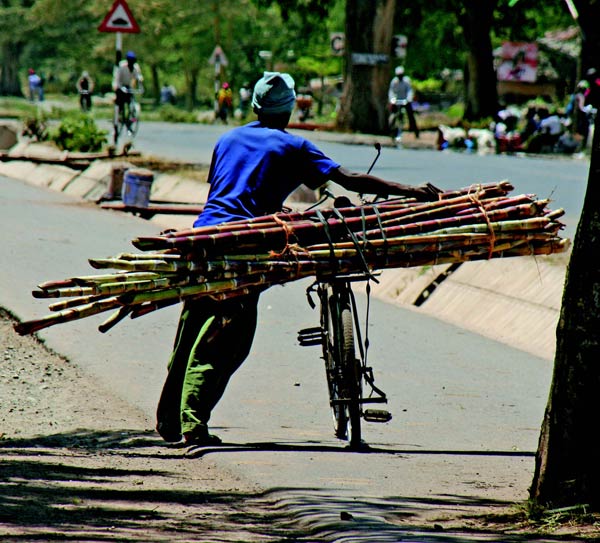When Randy was selected by the Peace Corps to go to Tanzania in 2006, my wife Jennifer and I hatched a plan to visit him halfway through his two-year “tour of duty.” Our goal was Two-fold—to get him out of his remote village for a while and for us to experience Africa, since we’d never been. We decided to break our trip into three segments—three days of traditional safari activities in national parks, three days in Randy’s village of Dawar and then four more days of safari to wrap things up.
As the trip approached this past fall, we read guide books and studied web-based sources to learn more about what we could expect. The abundant and amazing wildlife at parks such as Ngorongoro and Tarangire was well documented. Their tourist lodges had all the amenities—bathrooms with flush toilets, running water, hot showers and electric outlets; first class dining rooms with salads, soups and recognizable meat products; and lounges with excellent selections of good wine and cold beer. Now, that’s a vision any Danvillite can appreciate!
But Dawar was noticeably absent from the web, other than a few Christian missionary sites. We knew it was on the southern flanks of Mt Hanang, but it was not on our detailed map of Tanzania. The only nearby town shown on the map was Katesh where Randy gets his mail, does his shopping and has limited access to the internet—and that’s several miles away from Dawar. Randy’s village was clearly not considered a popular tourist destination.
Because of our unique itinerary, Randy handled most of the incountry schedule by working with a Tanzanian company named Safari Makers. We also needed help arranging our international flights. The reduced number of airline flights with tight connections, new baggage fees and restrictions, upgradeable airline seats, airport overnight stay hotels, etc. made it more complex than we could handle via the web. The professional travel planners at Danville Travel smoothed everything out for us.
The flight segments were long and we were very happy when we finally arrived at Kilimanjaro airport. That very afternoon we headed to Lake Manyara and saw a wide assortment of wildlife. We spent the following two days at Ngorongoro Crater, photographing every African animal that anyone could hope to. Even outside the main safari areas, there was always something fascinating to see right next to the road whether plant, animal or human in nature (sometimes, up close and personal). The sunsets were glorious, the lodges were comfortable,
and the food was great. It was clear this was going to become one of those “lifetime adventures.”
On the appointed day, we headed south towards Dawar. After just a few miles on route A104, the pavement ended—our first hint that we were heading away from the amenities of civilization. We endured a three hour drive over the most bumpy, dusty, narrow roads imaginable. Dust-devils swirled over our car and oncoming cargo trucks hugged the center of the dirt road, forcing us to often drive on the shoulder. It was a bone-jarring, teeth- rattling ride in our hired 4WD Land Cruiser, but our guide Welking persevered and we made it through.
When we finally arrived in Randy’s village, we unloaded our bags and walked into his house. It was a small rectangular concrete slab with mud-covered cinder block walls and a tin roof. The reality of our situation jumped on Jen and I like a hungry leopard on its prey. We watched through the long cracks in the front door as a calf walked by outside. The only furniture was a mattress on the floor and a handbuilt book case, which doubled as Randy’s dresser. There was no electricity (the power lines stopped a few miles away when the TZ power company ran out of money). There was no running water (the community between Dawar and a nearby natural springs took most of it for their use). During the dry months, Randy joined the villagers on their trek to the springs to fill up a 5 gallon plastic container every few days, although he occasionally hitched a ride on a passing ox cart. Obviously, there was no flush toilet, no hot showers, no microwave oven nor refrigerator, etc. The only light at night was provided by a few candles. Frankly, we were shocked at his living conditions—even our most modest expectations were not met. While we’d traveled only a few hours by car, it seemed that we’d stepped centuries back in time.
Both Jen and I needed to take “a moment” and get a grip on this unexpected situation. She went outside, found a shady spot under an acacia tree and composed herself. I grabbed a broom and swept the dust and rodent droppings off the floor. Randy chased down the mice with a pair of salad tongs and ejected them from the house for our benefit (I’m sure they punished him for this indiscretion after we left).
Each of our days began with Randy boiling a pot of water over a small brazier outdoors. To maintain a hot flame, he used dried corn cobs and charcoal for fuel. From this small pot we made cups of tea, washed our faces and brushed our teeth. I was constantly reminded of emotions from my USMC survival school days—a huge difference from life in Danville, or even our safari lodges! Our trip had abruptly shifted gears from being a majestic wildlife safari to one of intense cultural interaction with tribal villagers.
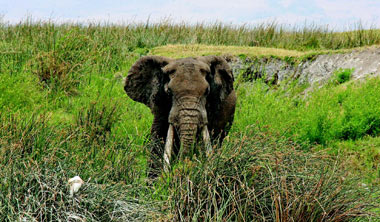 |
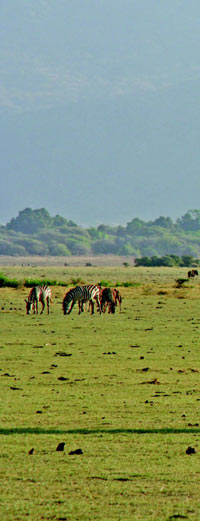 |
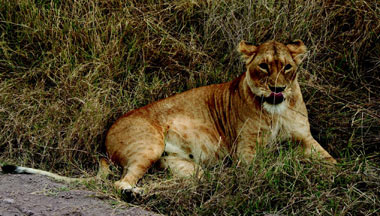 |
|
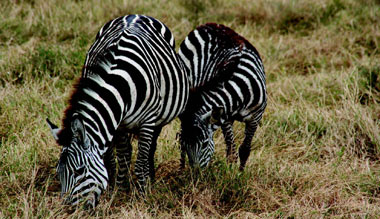 |
The people of Dawar and the surrounding region still share their home with a variety of “original residents.”
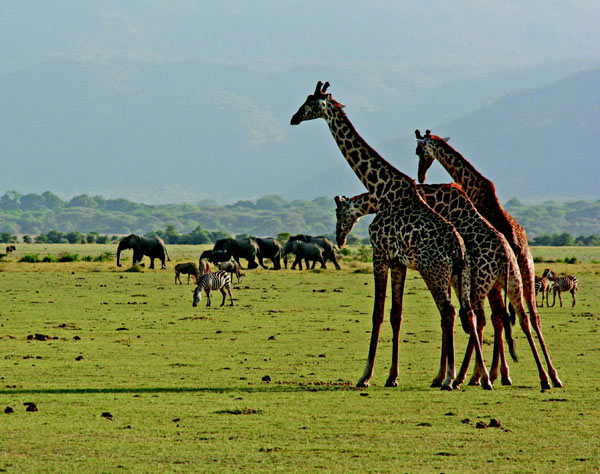
We soon learned that a few of the locals lived in better houses than Randy’s—but many were worse. This area was a tough place to eke out a living, either as a farmer or a cattle herder. Yet, as difficult and primitive as their daily living conditions are, we found the Barabaig and Iraqqw tribal people to be extremely friendly and engaging. Jen and I were welcomed with the gift of a live chicken, a considerable portion of the donor’s net worth. We were pleasantly surprised by a village-wide welcome celebration thrown in our honor the first evening. During an incredibly lively and colorful dance ceremony, we were given traditional dress costumes and made to feel at home. During the walk home that night, however, we had to mentally balance between watching the fantastic night sky, with zillions of bright stars, and the path ahead, which might harbor snakes and hyenas looking for easy prey. Based on thousands of years of tribal knowledge, villagers are aware they must fully live for today—tomorrow is not guaranteed.
Over the next two days and nights, we were ushered into many homes with the greeting “karibuni sana,” which means “you are most welcome” in Swahili. The family father or mother would motion for us to sit on wooden stools, sometimes with a baby goat nestled under it to protect it from hyenas at night. We were always served a cup of chai (hot tea) and often a meal of ugali (corn porridge) or hard-boiled eggs. A lengthy conversation would then ensue, with Randy doing an excellent job of interpreting between English and Swahili.
Randy introduced us to a wide variety of people. We met with various community leaders such as the local doctor, church pastors, Christian missionaries, school principals, teachers and business people. We also spent quality time with a brickmaker, cattle herders, farmers and ox-cart drivers. During one late afternoon stroll, we came upon the local blacksmith, who hand-made fashionable bracelets as gifts for us, working all evening to finish them.
The genuine hospitality of all the villagers was heart-rending, considering this inhospitable countryside with such scarce resources to draw from. While their material possessions are few, their spiritual wealth is great.
 |
 |
 |

The Peace Corps is currently helping the villagers obtain funding to dig a well and to expand their basic community clinic. Also, the few relatively-wealthy villagers created an economic assistance co-op program to help others get started with businesses (the average loan is around $20). So far, it has resulted in the opening of a new butcher shop, a corn seed store and a “fast food diner” whose specialty is a mixture of scrambled eggs and grilled potatoes. It is amazing how so little money (to us) can be put to such great use in a village like this.
While Jen and I were happy to get back to a safari lodge after our three-day stay in Dawar, we were psychologically “conflicted.” We had been granted a rare and valuable experience by interacting with these rural villagers on a personal level, leveraging friendships created by Randy to penetrate the veil that normally lies between cultural strangers. We discovered that the true measure of “civilization” lies not with a society’s level of sophistication or technology, but with their human interaction and social support systems.

 |
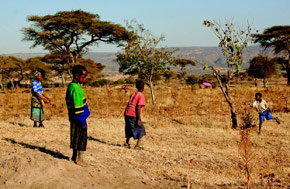 |
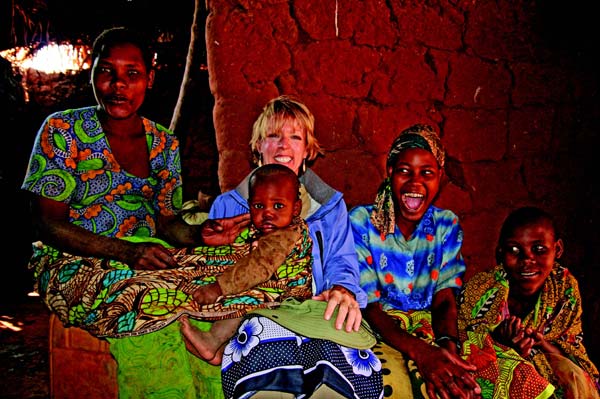
I hope that we who live in Danville will be as civilized as the Dawar folks when that 8.0 earthquake disrupts our transportation system, shreds our electric power grid, and destroys
our ability to communicate with the outside world. If our citizens overcome their personal hardships and assist each other as the Dawar villagers do every day, then we will pass the real test of humanity.
Randy has made the transition well, albeit not how we expected when the Peace Corps first signed him up. Perhaps the ultimate test for a “social services worker” is the respect given him by those he is trying to help. Randy is held in such high regard that he was inducted into the tribe as an honorary warrior during that village-wide ceremony our first day. He may be the first Chico State graduate “licensed” to carry a spear when he goes for a walk in the bush—and it’s not just for show. While this was never on the parental list of career expectations, we are very proud of him.
To assist Randy with his clinic expansion project, visit www.peacecorps.gov, click on “Donate Now”, and do a “Search by Volunteer” using the name “Fish”.
Since 1994, the founders of two American sister companies, the AMIAS Project and Another Land, have been working with the Barabaig tribe to foster cultural pride, conservation and innovation. To provide adventurous travelers with a once-in-a-lifetime cultural opportunity, Another Land offers tours where guests interact with people that live in Randy’s area (www.anotherland.com). For those who prefer assisting the tribal craftspeople from the comfort of their home, the AMIAS Project has an online gift shop with a wide range of fair-trade Barabaig jewelry and accessories (www.amias.org).
BOB FISH
